Example Algorithms CSE 2320 Algorithms and Data Structures
































![Next Version • id[p] will not point to the set_id of p. – It Next Version • id[p] will not point to the set_id of p. – It](https://slidetodoc.com/presentation_image_h/a444bef0372904b9d2090a964f9118d0/image-33.jpg)
![Second Version int find(int object, int id[]) { int next_object; next_object = id[object]; while Second Version int find(int object, int id[]) { int next_object; next_object = id[object]; while](https://slidetodoc.com/presentation_image_h/a444bef0372904b9d2090a964f9118d0/image-34.jpg)













![Third Version main() { int p, q, i, id[N], sz[n], p_id, q_id; for (i Third Version main() { int p, q, i, id[N], sz[n], p_id, q_id; for (i](https://slidetodoc.com/presentation_image_h/a444bef0372904b9d2090a964f9118d0/image-48.jpg)










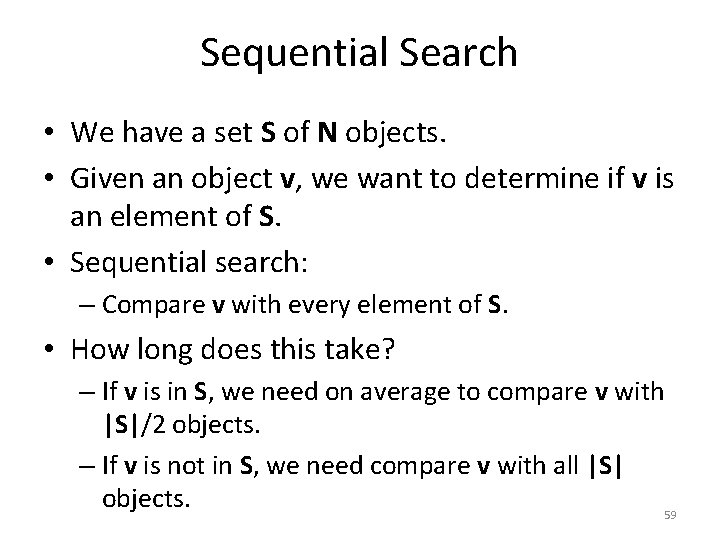

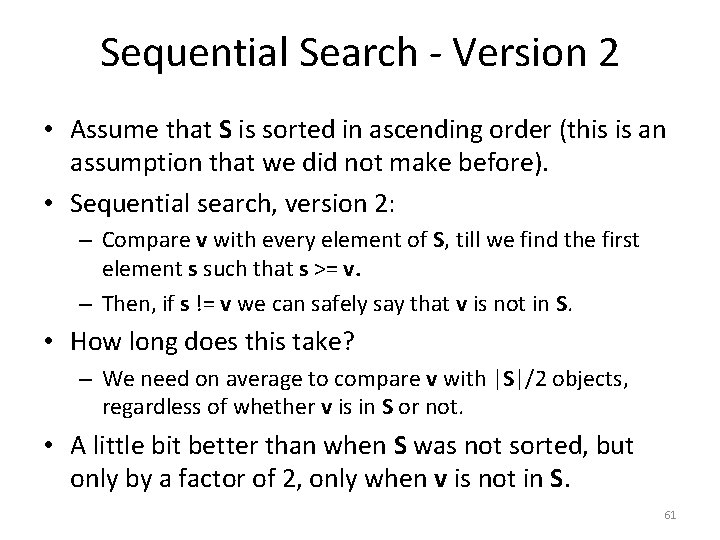

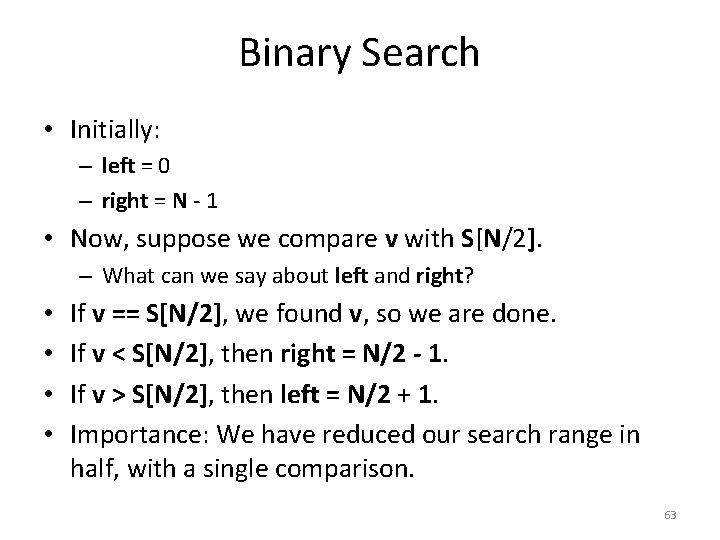
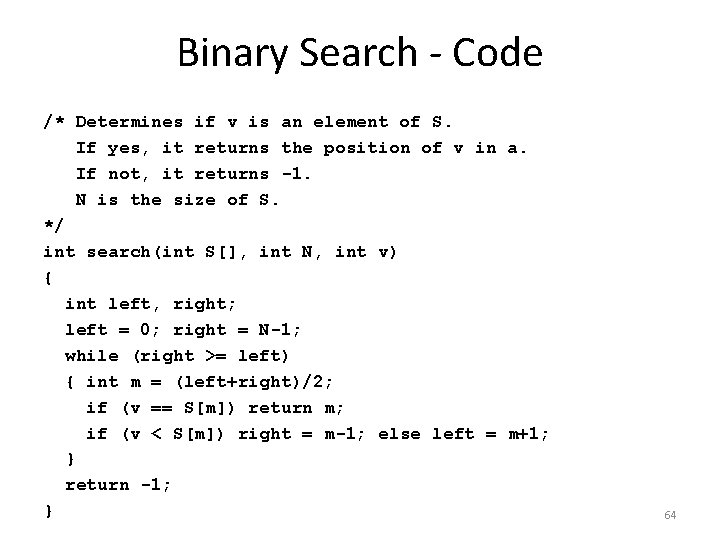
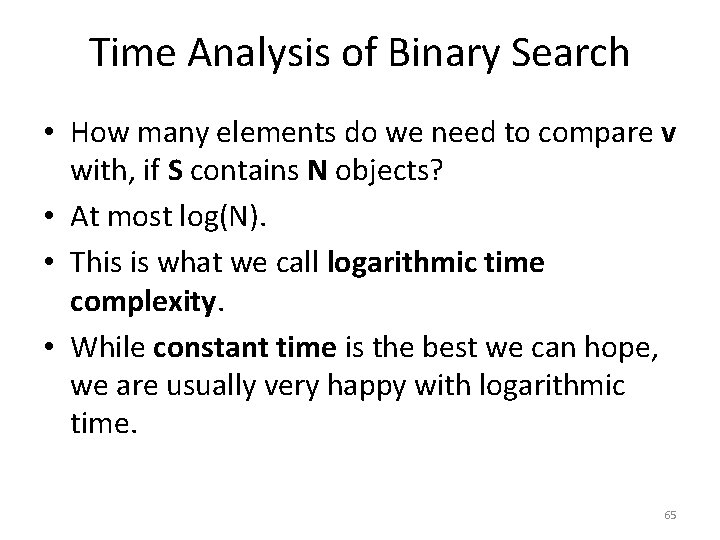
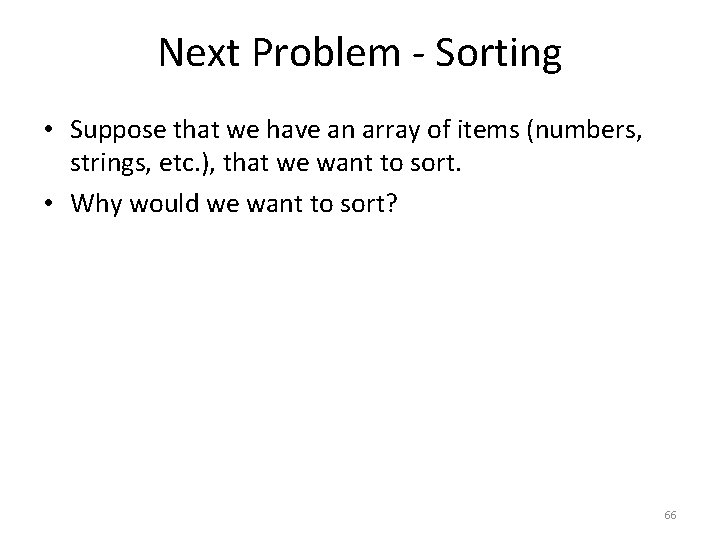
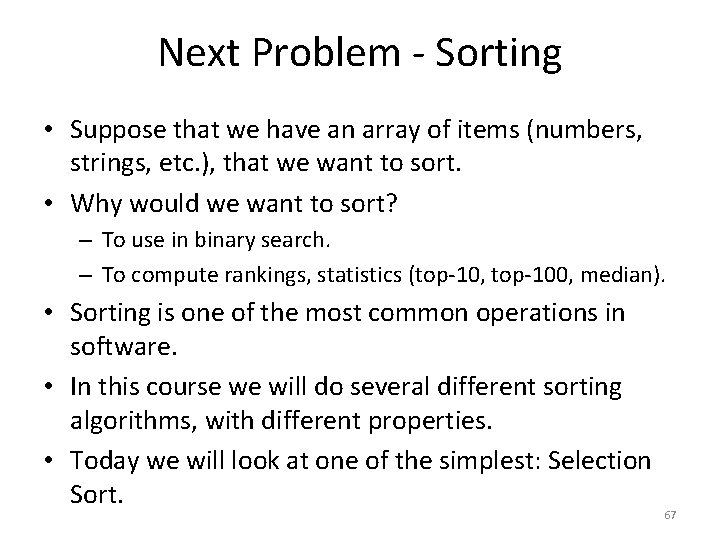
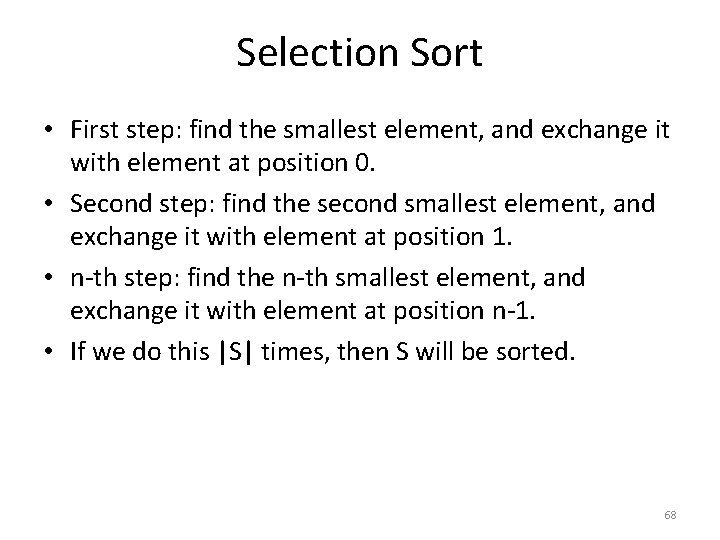
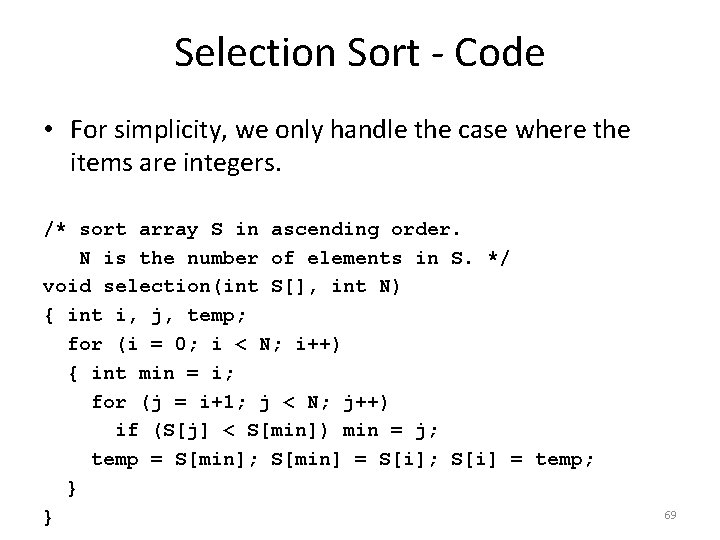
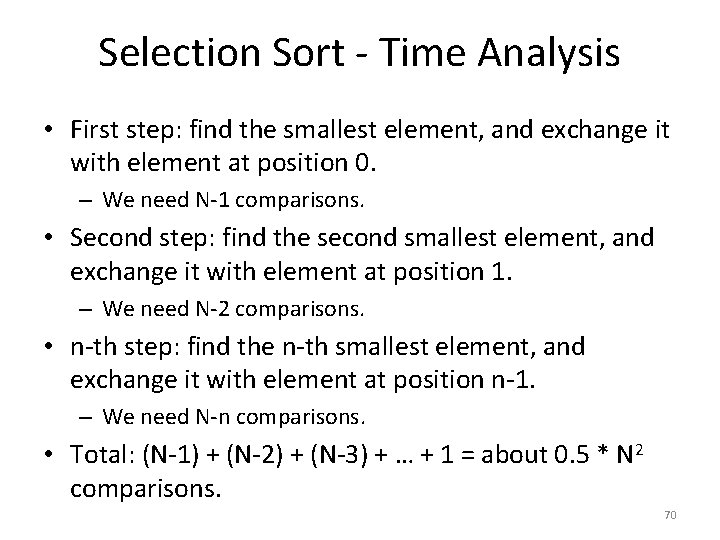
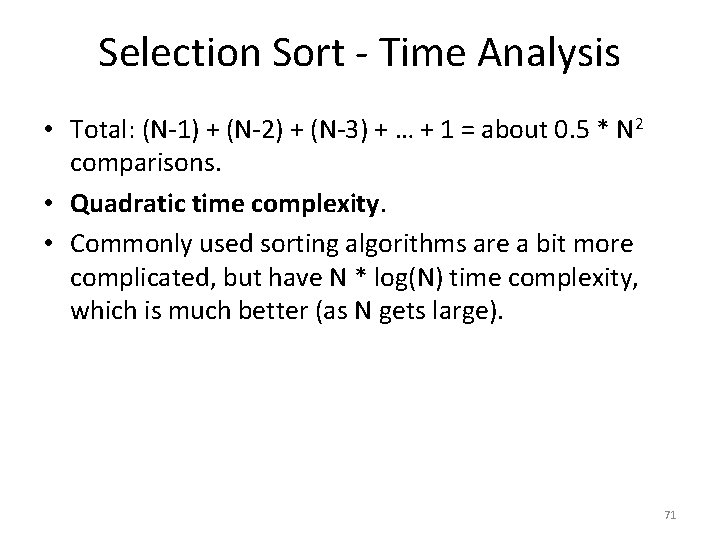
- Slides: 71

Example Algorithms CSE 2320 – Algorithms and Data Structures Vassilis Athitsos University of Texas at Arlington 1

Examples of Algorithms • • Union-Find. Binary Search. Selection Sort. What each of these algorithms does is the next topic we will cover. 2

Connectivity: An Example • Suppose that we have a large number of computers, with no connectivity. – No computer is connected to any other computer. • We start establishing direct computer-tocomputer links. • We define connectivity(A, B) as follows: – If A and B are directly linked, they are connected. – If A and B are connected, and B and C are connected, then A and C are connected. • Connectivity is transitive. 3

The Union-Find Problem • We want a program that behaves as follows: – Each computer is represented as a number. – We start our program. – Every time we establish a link between two computers, we tell our program about that link. • How do we tell the computer? What do we need to provide? 4

The Union-Find Problem • We want a program that behaves as follows: – Each computer is represented as a number. – We start our program. – Every time we establish a link between two computers, we tell our program about that link. • How do we tell the computer? What do we need to provide? • Answer: we need to provide two integers, specifying the two computers that are getting linked. 5

The Union-Find Problem • We want a program that behaves as follows: – Each computer is represented as a number. – We start our program. – Every time we establish a link between two computers, we tell our program about that link. – We want the program to tell us if the new link has changed connectivity or not. • What does it mean that "connectivity changed"? 6

The Union-Find Problem • We want a program that behaves as follows: – Each computer is represented as a number. – We start our program. – Every time we establish a link between two computers, we tell our program about that link. – We want the program to tell us if the new link has changed connectivity or not. • What does it mean that "connectivity changed"? • It means that there exist at least two computers X and Y that were not connected before the new link was in place, but are connected now. 7

The Union-Find Problem • We want a program that behaves as follows: – Each computer is represented as a number. – We start our program. – Every time we establish a link between two computers, we tell our program about that link. – We want the program to tell us if the new link has changed connectivity or not. • Can you come up with an example where the new link does not change connectivity? 8

The Union-Find Problem • We want a program that behaves as follows: – Each computer is represented as a number. – We start our program. – Every time we establish a link between two computers, we tell our program about that link. – We want the program to tell us if the new link has changed connectivity or not. • Can you come up with an example where the new link does not change connectivity? • Suppose we have computers 1, 2, 3, 4. Suppose 1 and 2 are connected, and 2 and 3 are connected. Then, 9 directly linking 1 to 3 does not add connectivity.

The Union-Find Problem • We want a program that behaves as follows: – Each computer is represented as a number. – We start our program. – Every time we establish a link between two computers, we tell our program about that link. – We want the program to tell us if the new link has changed connectivity or not. – How do we do that? 10

A Useful Connectivity Property • Suppose we have N computers. • At each point (as we establish links), these N computers will be divided into separate networks. – All computers within a network are connected. – If computers A and B belong to different networks, they are not connected. • Each of these networks is called a connected component. 11

Initial Connectivity • Suppose we have N computers. • Before we have established any links, how many connected components do we have? 12

Initial Connectivity • Suppose we have N computers. • Before we have established any links, how many connected components do we have? – N components: each computer is its own connected component. 13

Labeling Connected Components • Suppose we have N computers. • Suppose we have already established some links, and we have K connected components. • How can we keep track, for each computer, what connected component it belongs to? 14

Labeling Connected Components • Suppose we have N computers. • Suppose we have already established some links, and we have K connected components. • How can we keep track, for each computer, what connected component it belongs to? – Answer: maintain an array id of N integers. – id[p] will be the ID of the connected component of computer p (where p is an integer). – For convenience, we can establish the convention that the ID of a connected component X is just some integer p such that computer p belongs to X. 15

The Union-Find Problem • We want a program that behaves as follows: – Each computer is represented as a number. – We start our program. – Every time we establish a link between two computers, we tell our program about that link. – We want the program to tell us if the new link has changed connectivity or not. – How do we do that? 16

Union-Find: First Solution • It is rather straightforward to come up with a brute force method: • Every time we establish a link between p and q: – The new link means p and q are connected. – If they were already connected, we do not need to do anything. – How can we check if they were already connected? 17

Union-Find: First Solution • It is rather straightforward to come up with a brute force method: • Every time we establish a link between p and q: – The new link means p and q are connected. – If they were already connected, we do not need to do anything. – How can we check if they were already connected? • Answer: id[p] == id[q] 18

Union-Find: First Solution • It is rather straightforward to come up with a brute force method: • Every time we establish a link between p and q: – The new link means p and q are connected. – If they were not already connected, then the connected components of p and q need to be merged. 19

Union-Find: First Solution • It is rather straightforward to come up with a brute force method: • Every time we establish a link between p and q: – The new link means p and q are connected. – If they were not already connected, then the connected components of p and q need to be merged. – We can go through each computer i in the network, and if id[i] == id[p], we set id[i] = id[q]. 20

Union-Find: First Solution #include <stdio. h> #define N 10000 main() { int i, p, q, t, id[N]; for (i = 0; i < N; i++) id[i] = i; while (scanf("%d %dn", &p, &q) == 2) { if (id[p] == id[q]) continue; for (t = id[p], i = 0; i < N; i++) if (id[i] == t) id[i] = id[q]; printf(" %d %dn", p, q); } } 21

Time Analysis • The first solution to the Union-Find problem takes at least M*N instructions, where: – N is the number of objects. – M is the number of union operations. • What is the best case, that will lead to faster execution? 22

Time Analysis • The first solution to the Union-Find problem takes at least M*N instructions, where: – N is the number of objects. – M is the number of union operations. • What is the best case, that will lead to faster execution? – Best case: all links are identical, we only need to do one union. Then, we need at least N instructions. 23

Time Analysis • The first solution to the Union-Find problem takes at least M*N instructions, where: – N is the number of objects. – M is the number of union operations. • What is the worst case, that will lead to the slowest execution? 24

Time Analysis • The first solution to the Union-Find problem takes at least M*N instructions, where: – N is the number of objects. – M is the number of union operations. • What is the worst case, that will lead to the slowest execution? – Worst case: each link requires a new union operation. Then, we need at least N*L instructions, where L is the number of links. 25

Time Analysis • The first solution to the Union-Find problem takes at least M*N instructions, where: – N is the number of objects. – M is the number of union operations. – L is the number of links. • Source of variance: M. In the best case, M = ? ? ? . In the worst case, M = ? ? ? . 26

Time Analysis • The first solution to the Union-Find problem takes at least M*N instructions, where: – N is the number of objects. – M is the number of union operations. – L is the number of links. • Source of variance: M. In the best case, M = 1. In the worst case, M = L. 27

The Find and Union Operations • find: given an object p, find out what set it belongs to. • union: given two objects p and q, unite their two sets. • Time complexity of find in our first solution: – ? ? ? • Time complexity of union in our first solution: – ? ? ? 28

The Find and Union Operations • find: given an object p, find out what set it belongs to. • union: given two objects p and q, unite their two sets. • Time complexity of find in our first solution: – Just checking id[p]. – One instruction in C, a constant number of instructions on the CPU. • Time complexity of union in our first solution: – At least N instructions, if p and q belong to different sets. 29

Rewriting First Solution With Functions - Part 1 #include <stdio. h> #define N 10 /* Made N smaller, so we can print all ids */ /* returns the set id of the object. */ int find(int object, int id[]) { return id[object]; } /* unites the two sets specified by set_id 1 and set_id 2*/ void set_union(int set_id 1, int set_id 2, int id[], int size) { int i; for (i = 0; i < size; i++) if (id[i] == set_id 1) id[i] = set_id 2; } 30

Rewriting First Solution With Functions - Part 2 main() { int p, q, i, id[N], p_id, q_id; for (i = 0; i < N; i++) id[i] = i; while (scanf("%d %d", &p, &q) == 2) { p_id = find(p, id); q_id = find(q, id); if (p_id == q_id) { printf(" %d and %d were on the same setn", p, q); continue; } set_union(p_id, q_id, N); printf(" %d %d link led to set unionn", p, q); for (i = 0; i < N; i++) printf(" id[%d] = %dn", i, id[i]); } } } 31

Why Rewrite? • The rewritten code makes the find and union operations explicit. • We can replace find and union as we wish, and we can keep the main function unchanged. • Note: union is called set_union in the code, because union is a reserved keywords in C. • Next: try different versions of find and union, to make the code more efficient. 32
![Next Version idp will not point to the setid of p It Next Version • id[p] will not point to the set_id of p. – It](https://slidetodoc.com/presentation_image_h/a444bef0372904b9d2090a964f9118d0/image-33.jpg)
Next Version • id[p] will not point to the set_id of p. – It will point to just another element of the same set. – Thus, id[p] initiates a sequence of elements: – id[p] = p 2, id[p 2] = p 3, …, id[pn] = pn • This sequence of elements ends when we find an element pn such that id[pn] = pn. • We will call this pn the id of the set. • This sequence is not allowed to contain cycles. • We re-implement find and union to follow these rules. 33
![Second Version int findint object int id int nextobject nextobject idobject while Second Version int find(int object, int id[]) { int next_object; next_object = id[object]; while](https://slidetodoc.com/presentation_image_h/a444bef0372904b9d2090a964f9118d0/image-34.jpg)
Second Version int find(int object, int id[]) { int next_object; next_object = id[object]; while (next_object != id[next_object]) next_object = id[next_object]; return next_object; } /* unites the two sets specified by set_id 1 and set_id 2 */ void set_union(int set_id 1, int set_id 2, int id[], int size) { id[set_id 1] = set_id 2; } 34

id Array Defines Trees of Pointers • By drawing out what points to what in the id array, we obtain trees. – Each connected component corresponds to a tree. – Each object p corresponds to a node whose parent is id[p]. – Exception: if id[p] == p, then p is the root of a tree. • In first version of Union-Find, a connected component of two or more objects corresponded to a tree with two levels. • Now, a connected component of n objects (n >= 2) can have anywhere from 2 to n levels. • See textbook figures 1. 4, 1. 5 (pages 13 -14). 35

Time Analysis of Second Version • How much time does union take? • How much time does find take? 36

Time Analysis of Second Version • How much time does union take? – a constant number of operations (which is the best result we could hope for). • How much time does find take? – find(p) needs to find the root of the tree that p belongs to. This needs at least as many instructions as the distance from p to the root of the tree. 37

Time Analysis of Second Version • Worst case? 38

Time Analysis of Second Version • Worst case: we process M links in this order: – – – 10 21 32 … M M-1 • Then, how will the ids look after we process each link? 39

Time Analysis of Second Version • Worst case: we process M links in this order: – – – 10 21 32 … M M-1 • Then, how will the ids look after we process the m-th link? – id[m] = m-1, id[m-1] = m-2, id[m-2] = m-3, … 40

Time Analysis of Second Version • Worst case: we process links in this order: – 1 0, 2 1, 3 2, …, M M-1. • Then, how will the ids look after we process each link? – id[m] = m-1, id[m-1] = m-2, id[m-2] = m-3, … • How many instructions will find take? 41

Time Analysis of Second Version • Worst case: we process links in this order: – 1 0, 2 1, 3 2, …, M M-1. • Then, how will the ids look after we process each link? – id[m] = m-1, id[m-1] = m-2, id[m-2] = m-3, … • How many instructions will find take? – at least m instructions for the m-th link. • Total? 42

Time Analysis of Second Version • Worst case: we process links in this order: – 1 0, 2 1, 3 2, …, M M-1. • Then, how will the ids look after we process each link? – id[m] = m-1, id[m-1] = m-2, id[m-2] = m-3, … • How many instructions will find take? – at least m instructions for the m-th link. • Total? 1 + 2 + 3 + … + M = 0. 5 * M * (M+1). So, at least 0. 5 * M 2 instructions. Quadratic in M. • Compare to first version: M*N. Which is better? 43

Time Analysis of Second Version • Worst case: we process links in this order: – 1 0, 2 1, 3 2, …, M M-1. • Then, how will the ids look after we process each link? – id[m] = m-1, id[m-1] = m-2, id[m-2] = m-3, … • How many instructions will find take? – at least m instructions for the m-th link. • Total? 1 + 2 + 3 + … + M = 0. 5 * M * (M+1). So, at least 0. 5 * M 2 instructions. Quadratic in M. • Compare to first version: M*N. Which is better? – The new version, if M < N. 44

Time Analysis of Second Version • Worst case: we process links in this order: – 1 0, 2 1, 3 2, …, M M-1. • Then, how will the ids look after we process each link? – id[m] = m-1, id[m-1] = m-2, id[m-2] = m-3, … • What if M > N? • Then the number of instructions is: 1+2+3+…+N+N+…+N. • Still better than first version (where we need M*N instructions). Compare: 1+2+3+…+N+N+…+N (second version) N+N+N+…+N (first version) 45

Second Vs. First Version • The second version is faster, but not by much. – About two times faster. – A constant factor of two will not be considered a big deal in this class. – Preview of chapter 2: constant factors like this will mostly be ignored. 46

Third Version • find: same as in second version. • union: always change the id of the smaller set to that of the larger one. void set_union(int set_id 1, int set_id 2, int id[], int sz[]) { if (sz[set_id 1] < sz[set_id 2]) { id[set_id 1] = set_id 2; sz[set_id 2] += sz[set_id 1]; } else { id[set_id 2] = set_id 1; sz[set_id 1] += sz[set_id 2]; } 47 }
![Third Version main int p q i idN szn pid qid for i Third Version main() { int p, q, i, id[N], sz[n], p_id, q_id; for (i](https://slidetodoc.com/presentation_image_h/a444bef0372904b9d2090a964f9118d0/image-48.jpg)
Third Version main() { int p, q, i, id[N], sz[n], p_id, q_id; for (i = 0; i < N; i++) { id[i] = i; sz[i] = 1; } while (scanf("%d %d", &p, &q) == 2) { p_id = find(p, id); q_id = find(q, id); if (p_id == q_id) { printf(" %d and %d were on the same setn", p, q); continue; } set_union(p_id, q_id, sz); printf(" %d %d link led to set unionn", p, q); for (i = 0; i < N; i++) { printf(" id[%d] = %dn", i, id[i]); } } } 48

Time Analysis of Third Version • What is the key effect of considering the size of the two sets? 49

Time Analysis of Third Version • What is the key effect of considering the size of the two sets? • We get flatter trees. When we merge two trees, we avoid creating long chains. • How does that improve running time? 50

Time Analysis of Third Version • What is the key effect of considering the size of the two sets? • We get flatter trees. When we merge two trees, we avoid creating long chains. • How does that improve running time? • For a connected component of n objects, find will need at most log n operations. – Remember, log is always base 2. • Thus, now we need how many steps in total, for all the find operations in the program? 51

Time Analysis of Third Version • What is the key effect of considering the size of the two sets? • We get flatter trees. When we merge two trees, we avoid creating long chains. • How does that improve running time? • For a connected component of n objects, find will need at most log n operations. – Remember, log is always base 2. • Thus, now we need at most M * log N steps in total. 52

Optional: Fourth Version • As we go through a tree during a find operation, flatten the tree at the same time. int find(int object, int id[]) { int next_object; next_object = id[object]; while (next_object != id[next_object]) { id[next_object] = id[id[next_object]]; next_object = id[next_object]; } return next_object; } 53

Optional: Fourth Version • After repeated find operations, trees get flatter and flatter, and closer to the best case (two levels). int find(int object, int id[]) { int next_object; next_object = id[object]; while (next_object != id[next_object]) { id[next_object] = id[id[next_object]]; next_object = id[next_object]; } return next_object; } 54

Optional: Fourth Version • When all trees are flat (2 levels), how many operations does a single find take? 55

Optional: Fourth Version • When all trees are flat (2 levels), how many operations does a single find take? • It just needs to check id[p]. The number of operations does not depend on the size of the connected component, or the total number of objects. • When the number of operations does not depend on any variables, we say that the number of operations is constant. • A constant number of operations is algorithmically the best case we can ever hope for. 56

Next Problem: Membership Search • We have a set S of N objects. • Given an object v, we want to determine if v is an element of S. • For simplicity, now we will only handle the case where objects are integers. – It will become apparent later in the course that the solution actually works for much more general types of objects. • Can anyone think of a simple solution for this problem? 57

Sequential Search • We have a set S of N objects. • Given an object v, we want to determine if v is an element of S. • Sequential search: – Compare v with every element of S. • How long does this take? 58

Sequential Search • We have a set S of N objects. • Given an object v, we want to determine if v is an element of S. • Sequential search: – Compare v with every element of S. • How long does this take? – If v is in S, we need on average to compare v with |S|/2 objects. – If v is not in S, we need compare v with all |S| objects. 59

Sequential Search - Version 2 • Assume that S is sorted in ascending order (this is an assumption that we did not make before). • Sequential search, version 2: – Compare v with every element of S, till we find the first element s such that s >= v. – Then, if s != v we can safely say that v is not in S. • How long does this take? 60

Sequential Search - Version 2 • Assume that S is sorted in ascending order (this is an assumption that we did not make before). • Sequential search, version 2: – Compare v with every element of S, till we find the first element s such that s >= v. – Then, if s != v we can safely say that v is not in S. • How long does this take? – We need on average to compare v with |S|/2 objects, regardless of whether v is in S or not. • A little bit better than when S was not sorted, but only by a factor of 2, only when v is not in S. 61

Binary Search • Again, assume that S is sorted in ascending order. • At first, if v is in S, v can appear in any position, from 0 to N-1 (where N is the size of S). • Let's call left the leftmost position where v may be, and right the rightmost position where v may be. • Initially: – left = 0 – right = N - 1 • Now, suppose we compare v with S[N/2]. – Note: if N/2 is not an integer, round it down. – What can we say about left and right? 62

Binary Search • Initially: – left = 0 – right = N - 1 • Now, suppose we compare v with S[N/2]. – What can we say about left and right? • • If v == S[N/2], we found v, so we are done. If v < S[N/2], then right = N/2 - 1. If v > S[N/2], then left = N/2 + 1. Importance: We have reduced our search range in half, with a single comparison. 63

Binary Search - Code /* Determines if v is an element of S. If yes, it returns the position of v in a. If not, it returns -1. N is the size of S. */ int search(int S[], int N, int v) { int left, right; left = 0; right = N-1; while (right >= left) { int m = (left+right)/2; if (v == S[m]) return m; if (v < S[m]) right = m-1; else left = m+1; } return -1; } 64

Time Analysis of Binary Search • How many elements do we need to compare v with, if S contains N objects? • At most log(N). • This is what we call logarithmic time complexity. • While constant time is the best we can hope, we are usually very happy with logarithmic time. 65

Next Problem - Sorting • Suppose that we have an array of items (numbers, strings, etc. ), that we want to sort. • Why would we want to sort? 66

Next Problem - Sorting • Suppose that we have an array of items (numbers, strings, etc. ), that we want to sort. • Why would we want to sort? – To use in binary search. – To compute rankings, statistics (top-10, top-100, median). • Sorting is one of the most common operations in software. • In this course we will do several different sorting algorithms, with different properties. • Today we will look at one of the simplest: Selection Sort. 67

Selection Sort • First step: find the smallest element, and exchange it with element at position 0. • Second step: find the second smallest element, and exchange it with element at position 1. • n-th step: find the n-th smallest element, and exchange it with element at position n-1. • If we do this |S| times, then S will be sorted. 68

Selection Sort - Code • For simplicity, we only handle the case where the items are integers. /* sort array S in ascending order. N is the number of elements in S. */ void selection(int S[], int N) { int i, j, temp; for (i = 0; i < N; i++) { int min = i; for (j = i+1; j < N; j++) if (S[j] < S[min]) min = j; temp = S[min]; S[min] = S[i]; S[i] = temp; } } 69

Selection Sort - Time Analysis • First step: find the smallest element, and exchange it with element at position 0. – We need N-1 comparisons. • Second step: find the second smallest element, and exchange it with element at position 1. – We need N-2 comparisons. • n-th step: find the n-th smallest element, and exchange it with element at position n-1. – We need N-n comparisons. • Total: (N-1) + (N-2) + (N-3) + … + 1 = about 0. 5 * N 2 comparisons. 70

Selection Sort - Time Analysis • Total: (N-1) + (N-2) + (N-3) + … + 1 = about 0. 5 * N 2 comparisons. • Quadratic time complexity. • Commonly used sorting algorithms are a bit more complicated, but have N * log(N) time complexity, which is much better (as N gets large). 71